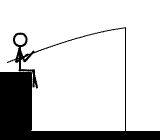Curty
Posts: 269
Joined: 11/25/2005
From: Barnard Castle,Durham County,UK
Status: offline

|
Malaria is a bloodborne disease spread by the female Anopheles mosquito (pronounced annofelless). The two most prevelent strains of malaria were falciparum and vivax. If not treated falciparum malaria had a high mortality rate. Infected patients symptoms were a chilly sensation lasting 20 - 36 hours, prostration, and headaches. Complications include 'celebral malaria' (severe headaches and delerium), and 'Blackwater fever', so called because the patients urine was darkened with dead blood cells. Both complications were usually fatal.
Vivax had a lower mortality rate, but was more common and more persistant in the body.
In the case of Vivax the patient was observed to have chills, followed by fever and sweats. The fever lasted 1 -8 hours, then the patient usually felt well until the next attack around 48 hours later. If untreated the symptoms subsided spontaniously in 10 - 30 days, but could recur at varying intervals.
At the beginning of the war quinine was thought to be the best treatment for malaria. but the capture of the cinchona plantations on Java by the Japs cut off supplies to the allies,forcing them to look at other drug development.
Plasmochin (dev.1924) was the first synthetic antimalarial. Highly effective in preventing relapses, but toxic and difficult to administer and so was abandoned early. Patients were developing stomache complaints, weakness, muscle-aches and diziness.
In 1943 clinical trials showed that appropriate doses of the new atabrine drug could cure falsiparum malaria, and if taken over a long period of time vivax malaria.
_____________________________
|
 Printable Version
Printable Version















 New Messages
New Messages No New Messages
No New Messages Hot Topic w/ New Messages
Hot Topic w/ New Messages Hot Topic w/o New Messages
Hot Topic w/o New Messages Locked w/ New Messages
Locked w/ New Messages Locked w/o New Messages
Locked w/o New Messages Post New Thread
Post New Thread